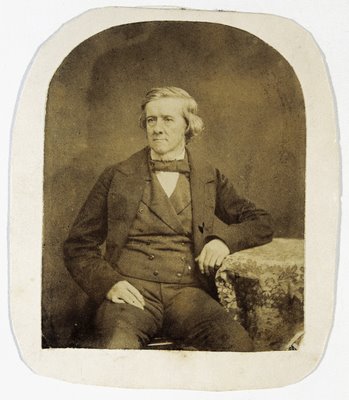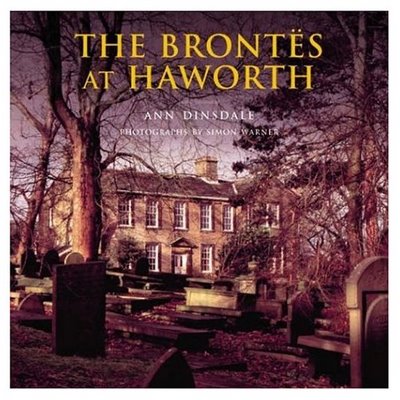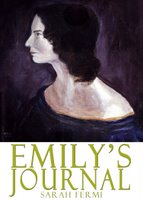
Pictured - Cornelia Parker with Phyllis Cheney, Friday 15 September 2006As the evening light fades in the Parsonage garden the eyes of fifty or so people, there for the official opening of the Cornelia Parker exhibition
Brontëan Abstracts, are focused on the open front door.
Backlit from within, a number of speakers stand one by one on the threshold to address the audience, beginning with the person whose idea it was to invite the artist in to do all this, deputy director of the museum Andrew McCarthy. Praise and thanks are duly distributed.
We are told that most of the people involved with the project are able to be here with us today. The two psychics - Henrietta Llewelyn Davies and Coral Temple - who led a séance here a few weeks ago to see who, or what, they could make contact with are not present. “But they are here in spirit,” adds Cornelia, smiling. The Radical Brontes Festival has now started, officially.
Before BBC Culture Show presenter Andrew Graham-Dixon declares the exhibition to be properly open, he apologises for the fact that he has not prepared anything for us(“I’ve only just had my personal preview”), then gives us what is almost a full item-by-item commentary, working from memory and a little blue notebook. Impressive! The usual rook chorus gets louder and louder.
We queue to go in, and we talk (I am with my daughter Daria) with Phyllis Cheney, who at ninety is amazing - extremely articulate and perceptive. A veteran member of the Brontë Society living in Plymouth, and a frequent visitor to Haworth, she has voiced her well-researched claims to be Branwell’s great-granddaughter before, most notably in a 1996 issue of Brontë Society
Transactions. “You’ll see me on a television screen inside later on,” she promises.
In the downstairs rooms, the quiet voices of the two psychics are coming out of little speakers on the floor. We find it hard to make much conventional sense out of them: occasional words and phrases can be registered. These are fragments of sound and meaning - appropriate for the occasion. The effect would be different if the crowd in the house was smaller.
Cornelia Parker’s additions, or rather enhancements, are in neat, unobtrusive frames on walls, objects connected with the Brontës seen afresh. Anne Brontë’s needle is the fallen mast of a tall ship on a bed of tangled rigging, a darn in her stocking a barred window, her stained handkerchief a record, we imagine, of when she once coughed blood into it. It might be of doubtful provenance, but what matter? This exhibition is about myths and their generation.
Emily’s hair is an underwater plant, thin fronds waving in a tropical sea, her burnt comb a series of stalagtites, her ink-splattered blotting paper worthy of display next to a Jackson Pollock, perhaps.
We talk about the blown-up deletions from the original manuscript of
Jane Eyre, semantic exercises trapped under glass. Why
vex rather than
annoy, why
conceived rather than
imagined, why
no sleep rather than
no rest?
A grey image of Charlotte’s pen nib is nearby, transformed by the magnification, a monumental slab of split stone, a menhir.
We browse the catalogue to dip into an interview by Andrew McCarthy. Cornelia is asked “Did you want to add to the mythology or try and strip it away?” She replies:
It’s a mythology I am very captivated by, the same as everyone else. The mythology is created by people’s imaginations and what I’d like to do is find a new space within it, a new way of looking at it, by returning to the source. By taking the objects that the Brontës owned, or actual physical traces like locks of their hair, and examining these very closely to try to see something that they might not even have witnessed themselves.We reach the television screen to watch Phyllis reading her
Transactions article and talking with husband Arthur. Her great grandmother, Mary Ann Judson (b 1839) was, she is convinced, the illegitimate child of Branwell Brontë and Martha Judson. She stands beside us to watch it again. “Some people believe it, some don’t of course,” she says. I tell her that she has convinced me. “I know that Tom Winnifrith, who made a study of Branwell, is scornful, because he told me so, but I am not so sure about what Brian Wilks thinks.”
Downstairs in the shop, where there is a wine reception, I talk with the artist, mentioning that a number of people have claimed that Branwell was an ancestor over the years. “Yes,” she says, “but not all of them have the same credibility. I sensed that Phyllis was special as soon as I knew about her. I’m like a Geiger Counter!”
Richard Wilcocks






















